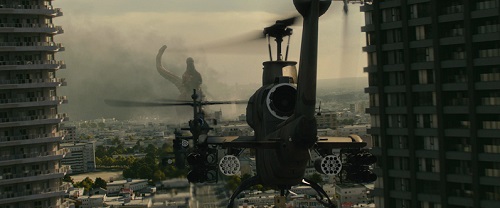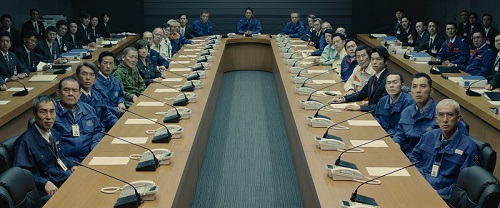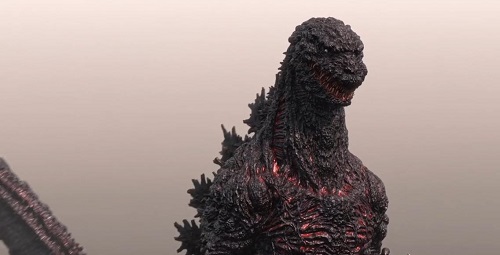Synopsis: Japan is plunged into chaos upon the appearance of a giant monster.
Release Date: October 11, 2016 MPAA Rating: PG-13
Genre(s): Action, Adventure
Film Review

Production
Does everyone remember back in 1999 when, after Roland Emmerich’s disastrous American version of Godzilla, the Japanese Toho Company came back to reclaim its flagship franchise with its own Godzilla 2000? It seems as if Toho has done the same thing after 2014’s American Godzilla; now, we’ve got Shin Godzilla.
Shin Godzilla begins with a mysterious explosion in Tokyo Bay. At first, the Japanese government blames the blast on subterranean volcanic activity, but soon enough, video footage of the aftermath shows a “Giant Unidentified Life Form” within the chaos. When the lifeform comes ashore, it leaves a path of destruction in its wake. While the scientists determine that the beast – which they call Godzilla – is evolving in order to be more destructive, the bureaucrats debate whether they should opt for “extermination, capture, or expulsion.” They decide upon extermination, but killing the beast is going to be much easier said than done.

Also going by the title Godzilla Resurgence in some territories, Shin Godzilla owes little to any of Toho’s previous Godzilla movies; it represents a true and complete reboot. In this movie’s universe, Godzilla doesn’t exist until he comes ashore – there is no official canon, and the human characters have no idea what they’re dealing with. Shin Godzilla was directed by Hideaki Anno (the Evangelion anime series) and Shinji Higuchi (Attack on Titan) from a script written by Anno, and the filmmakers appear to have been given complete creative freedom with the property. It seems as if the only stipulation was that Tokyo had to be destroyed by the monster. And it is.
Of course, Anno and Higuchi don’t completely abandon the traditional Godzilla. Once he comes into his completely evolved form, the monster’s appearance is very much like the original 1954 kaiju – except he’s much bigger. In fact, he’s bigger than any previous Godzillas, including the most recent gargantuan American incarnation. His size isn’t the only difference; aside from the evolving thing, this Godzilla has a nuclear reactor in his body, so he’s pretty much all powerful.

At first, it seems as if Shin Godzilla is just scenes of Godzilla trampling Tokyo divided by scenes of the government trying to figure out how to stop him. But, it’s deeper than that. While the original 1954 Godzilla was a statement about anxiety over atomic weaponry and the devastation that befell Japan in the final years of WWII, Shin Godzilla seems to be a thinly veiled metaphor for the Tohoku earthquake of 2011 and the subsequent Fukushima Daiichi nuclear catastrophe. In the end, it’s more than just a monster movie – it becomes all about Japan handling their affairs so that the rest of the world doesn’t lose faith in them as a country. As if the analogy wasn’t crystal clear, one of the characters actually spells it out: “Man is more frightening than Gojira!”
On the one hand, Shin Godzilla is a throwback to the classic Godzilla movies, with an awesome combination of sheer terror and campy humor (both intentional and unintentional). On the other, it brings the Godzilla mythos into the 21st century by modernizing the classic Japanese kaiju vibe. Either way, Shin Godzilla is a Godzilla movie unlike any that you’ve ever seen.

Special Effects
A Godzilla movie is only as good as its monster, and the monster in Shin Godzilla is great. The beast was brought to life using a combination of animatronic puppetry and computer generated motion capture. For most of the movie, models were built of the monster and digitally rendered into VFX software, where the creatures could be animated through motion capture provided by actor Mansai Nomura. For the atomic breath and nuclear dorsal plates, the visuals are the usual CG rotoscope cloning technique that all modern sci-fi movies use, and they work well within the context of the movie. The special effects in Shin Godzilla don’t quite have the same charm as a man in a rubber suit, but they’re not as slippery slick as the American version, either, so it’s very much a classic-style Godzilla movie.

Cast and Crew
- Director(s): Hideaki Anno
- Producer(s): Yoshihiro SatôMasaya ShibusawaTaichi UedaKazutoshi Wadakura
- Screenwriter(s): Hideaki Anno
- Story:
- Cast: Hiroki Hasegawa (Rando Yaguchi)Yutaka Takenouchi (Hideki Akasaka)Satomi Ishihara (Kayoko Ann Patterson) Ren Ohsugi (Prime Minister Seiji Okochi)Akira Emoto (Ryuta Azuma)Kengo Kôra (Yusuke Shimura, Deputy Chief Cabinet Secretary)Mikako Ichikawa (Masao Zaizen, Integrated Chief of Staff)Pierre Taki (Saigo, Combat Leader)Kyûsaku Shimada (Katayama, Minister of Foreign Affairs)Ken Mitsuishi (Kozuka, Governor of Tokyo)Shingo Tsurumi (Yajima, Joint Staff Deputy)Kimiko Yo (Reiko Hanamori, Defense Minister)
- Editor(s): Hideaki Anno
- Cinematographer: Kosuke Yamada
- Production Designer(s):
- Costume Designer:
- Casting Director(s): Tsuyoshi Sugino
- Music Score: Shiro Sagisu
- Music Performed By:
- Country Of Origin: Japan